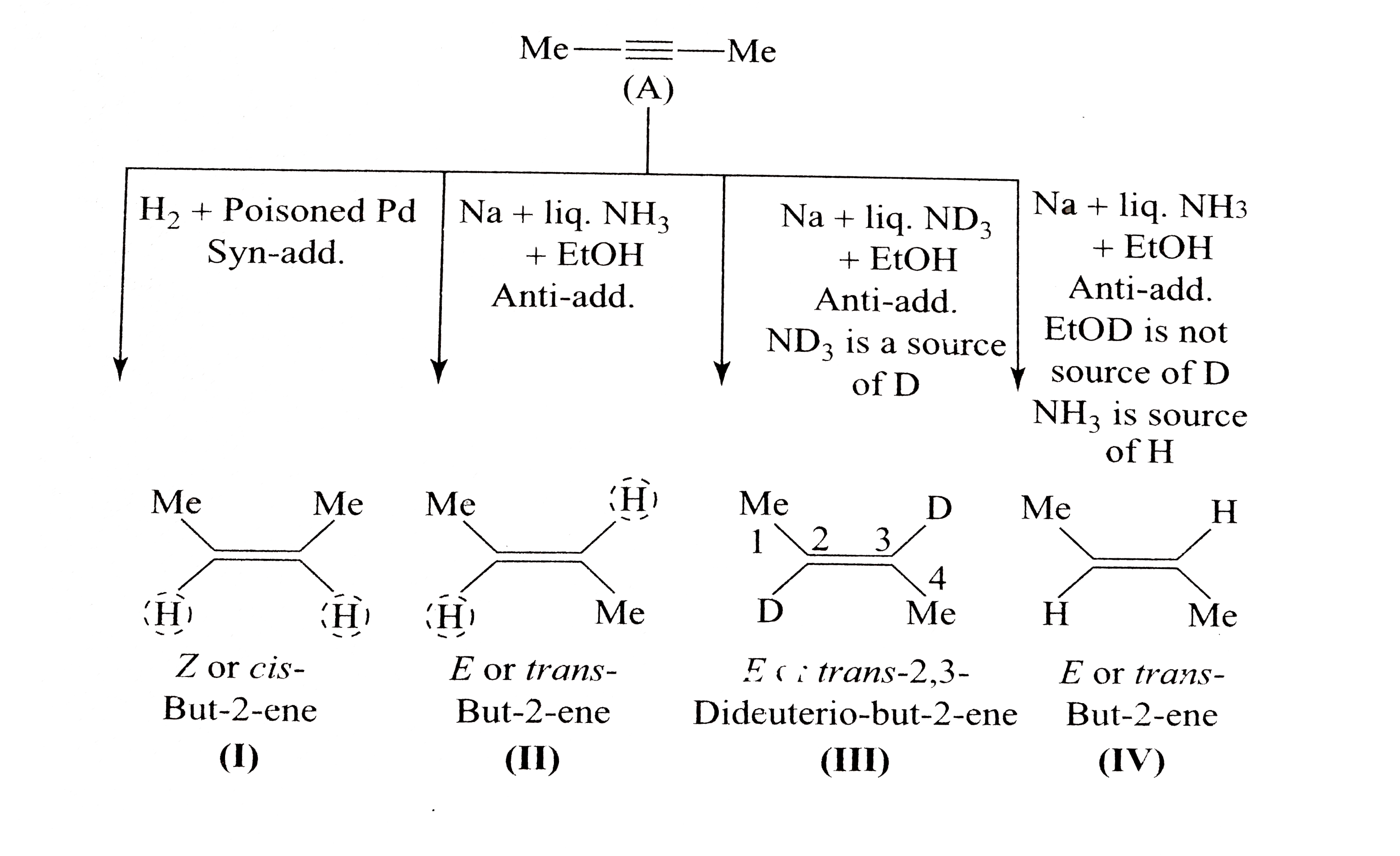Give the products with their stereoisomers, if any.
a. 
b.  cis −2,− Dibromobut−2−ene
cis −2,− Dibromobut−2−ene
c.  trans−2,3− Dibromobut−2−ene
trans−2,3− Dibromobut−2−ene
d. 
e. (H)trans-2,3-Dibromo-pent-2-eneH2+PtO2−−−−−→(I)
f.(J)cis-2,3-Dibromo-pent-2-eneH2+Pt+C−−−−−−→(K)
g. cis - But -2-ene D2+Pt−−−−→
h. trans− But −2− ene D2+Pd−−−−→
i. Why is the stereochemical product same when cis − or tans − pent −2− ene is hydrogenated with D2, in the presence of platinum ?
j.Classify the two reactions :(i) hydrogenenation of alkene with transition metala (Pt or Pd or Ni) and (ii) hydrogenation with Wilkinson's catalyst in terms of catalyst used and their mechanism of hydrogenation with Wilkinson's catalyst.
a. 
b. Note: Metal +H2 does not reduce (R−X) to (R−H) but reduces (Ar−X) to (Ar−H).
Reactant is cis + mechanism of addition is syn → product is meso.

c. Reactant is trans + mechanism of addition is syn → product is dl or (±) racemic.

d. Reactant is cis + mechanism of addition is syn → product is meso.

Meso−1,2−dymethyl cyclohexane (O.I.A.)
e. Reactant with two different groups + mechanism of addition is syn → product is dl or (±) or racemic.
 dl−2,3− Dibromopentane
dl−2,3− Dibromopentane
f. Reactant is cis with two different groups + mechanism of addiciton is syn → product id dl or (±) or racemic.
 dl−2,3−Dibromopentane
dl−2,3−Dibromopentane
g. Reactant is cis + meachanism of addition is syn → product is meso.

h. Reactant is trans + mechanism of addition is syn → product is (±) or dl or racemic.
 dl−2,3−Dideutereo− butane
dl−2,3−Dideutereo− butane
i. Reactant cis or trans ( with different groups )+ mechanism of addiction is syn → Product is always (±) or dl or racemic.

As there are two different groups in the alkene, the plane of symmetry is not attained. So the product is never obtained in meso from but optical isomers d and l are obtained from cis − or trans − alkene.
j. 
Both reactions are catalytic hydrogenation. Reation (1) is heterogenous catalytic hydrogenation in which the solid catalyst is in a different phase from the reactant (A)( gas phase ). Reaction (2) is homogenous cataytic hydrogenation because the reactant and the catalyst are in the same gaseous phase.
Topper's Solved these Questions
- ALKENES AND ALKADIENESBOOK - CENGAGE CHEMISTRYCHAPTER - ALKENES AND ALKADIENESEXERCISE - SOLVED Example
62 Videos
- ALKENES AND ALKADIENESBOOK - CENGAGE CHEMISTRYCHAPTER - ALKENES AND ALKADIENESEXERCISE - EXERCISES
29 Videos
- ALKANES AND CYCLOALKANESBOOK - CENGAGE CHEMISTRYCHAPTER - ALKANES AND CYCLOALKANESEXERCISE - Archives
13 Videos
- ALKYNESBOOK - CENGAGE CHEMISTRYCHAPTER - ALKYNESEXERCISE - Exercises (Archives - Analytical and Desriptive Type)
4 Videos
Similar Questions
Knowledge Check
trans-But−2−en on reaction with Br2in CCI4 forms
A(+)−2,3−dibromobutaneB(−)−2,3−dibrombutaneC(±)−2,3−dibromobutaneDmeso-dibromobutaneBut-2-ene exhibits cis-trans-isomerism due to
Arotaion around C3−C4 sigma bondBrestricted rotation around C=C bondCrotation around C1−C2 bondDrotation around C2−C3 double bond
Which of the two : trans-but-2-ene-or trans- pent-2- ene is non polar ?
View SolutionWhich of the two trans-but-2-ene or trans-pent-2.ene is non polar?
View SolutionHow will you prepare (i) cis-pent-2-ene and trans-pent-2-ene by starting with ethyne ?
View Solution2- bromopentane is heated with potassium ethoxide in ethanol the major product is
(A) Trans - pent- 2- ene
(B) 2- ethoxy pentane
(C) Pent-1-ene
(D) Cis pent - 2- ene
View SolutionWrite the hydrogenation product of following species with H2/Pd.
(a) 1,2-Butadiene H2/Pd−−−→ (b) trans-2-butene H2/Pd−−−→
(c) Benzaldehyde H2/Pd−−−→ (d)
View SolutionWrite the hydrogenation product of following species with H2/Pd.
(a) 1,2-Butadiene H2/Pd−−−→ (b) trans-2-butene H2/Pd−−−→
(c) Benzaldehyde H2/Pd−−−→ (d)
View Solution
